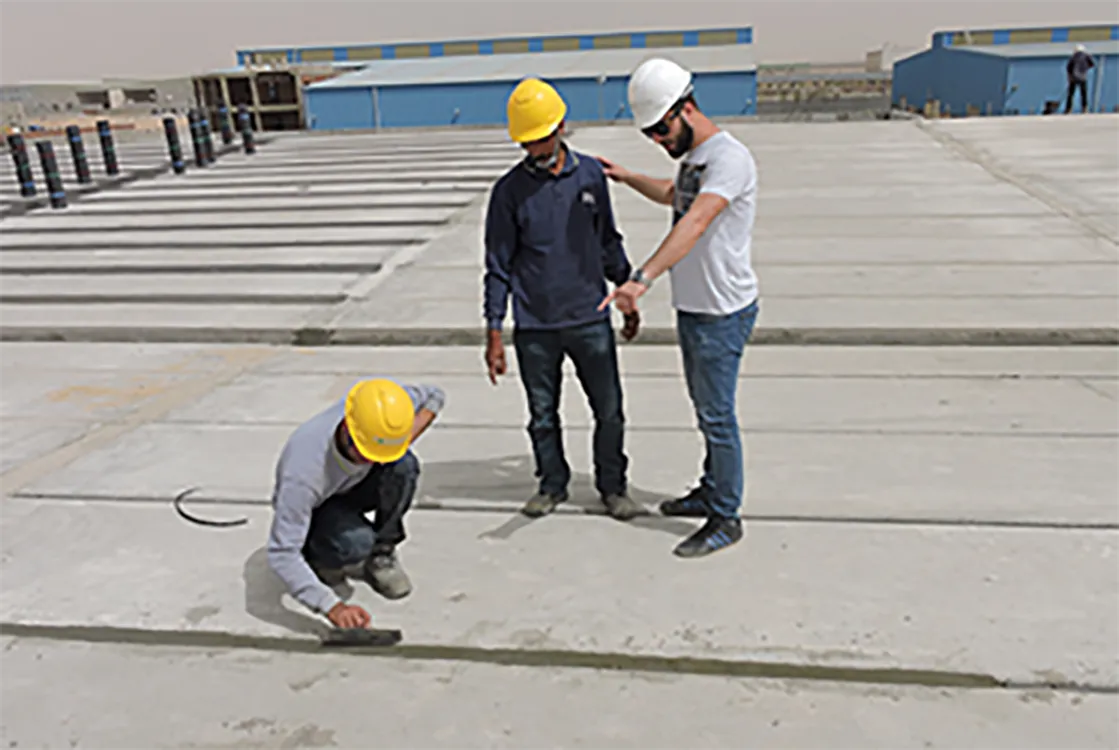
1. Prefabricated concrete slabs. 2. Poured-in-place concrete surfaces. First: Isolation of prefabricated concrete surfaces: 1-1 Insulating of Hollow Core slabs:
1-1-1- Filling the longitudinal joints:
1- An iron bar of 10 mm diameter shall be extended throughout the longitudinal joint with spacers of not less than 2.5 cm to secure a sufficient cover layer for the iron from the bottom and with emphasis on a riding distance at the iron connection points of not less than 50 cm.
2- The iron rod stops before the expansion joint in the transverse joints perpendicular to the longitudinal joints, and this is necessary to implement the expansion joint. 3- The separator shall be filled with a cement mortar consisting of sand, water and cement of 250 kg / m3. 4- The surface of the separator shall be finished and touched well, so that it is at the same level as the surface of the hollow core on each side. 5- If there are differences in the levels between two adjacent tiles that exceed 2 cm, this difference must be eliminated by pouring slight inclinations to fill the void.
2-1-1 Casting cross joints: The transverse joints mean the space between the two points of support of hollow core on its one delta, and it is about 20 cm wide and the thickness of hollow core, along its delta. 1. Two iron rods with a diameter of 10 mm are extended to be attached to the protruding bracket from the surface of the Rafter, while securing an overlap of not less than 50 cm at the connection points. 2. Installing 2 cm thick foam sheets with a hollow core height along the entire length of the expansion joint and fixing it in some way. 3. Casting the cross joint with a concrete mixture with a strength of 350 kg / cm2. 4. Good finishing and touching of the molded surface. 5. In the event that there are some poorly finished areas that contain protrusions or high protrusions, which are feared for the integrity of the insulation later, these areas are sanded with a missile.
3-1-1 Isolation of longitudinal joints: • The joint is painted with bituminous primer in order to increase the adhesion between the membrane and the concrete surface, where we paint a strip of about 30 cm wide. • A strip of bituminous membrane rolls, 3 mm thick and 25 cm wide, shall be attached, making sure to secure a vertical overlap of about 15 cm. Cross sectional insulation: • The separator shall be painted with a primer with a width of about 60 cm. Pasting a tape of bituminous membrane rolls, 3 mm thick, 50 cm wide, with a vertical overlap of about 15 cm.
4-1-1 expansion joints: The transverse expansion joints present in some transverse joints - according to the scheme - which were formed before casting those joints, are treated by placing foam strips 2 cm thick, with a height equal to the thickness of the holocore, then pouring those transverse joints as previously explained. Expansion joints are processed as follows: • The separator shall be cleaned along the entire length to a depth of approximately 4 cm. • A 3 cm diameter packing rod is placed and inserted into the cleaned space so as to leave a gap of 1 cm between the top of the packing rod and the surface of the holocore. • The void at the top of the packing rod in the remaining part - 1 cm - is filled with bituminous filler, the purpose of which is to fill this void completely. • Another packing rod of 3 cm thickness is placed above the filler and along the joint, to form a flexible thickness over which the membrane extends and allows adding an additional length to the membrane given when shrinking under low temperature conditions. • A sheet of membrane 3 mm thick and 50 cm wide is glued over the joint carefully without deforming the packing rod. • Another slice of screened membrane shall be attached as a final layer. Gutter Beams isolation: • The Gutter Beams are painted with a layer of bituminous primer. • A special coating for the drainage holes is made of membrane. • Pasting a first layer of membrane, 3 mm thick • Paste a second (final) layer of membrane, 3 mm thick - sanded - finished with a layer of sand. • The second layer is painted with an acrylic material for the outer surfaces, white color, to protect the insulator from sunlight.
